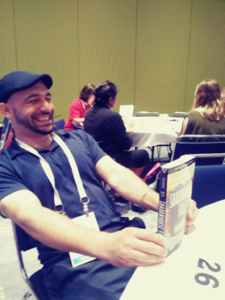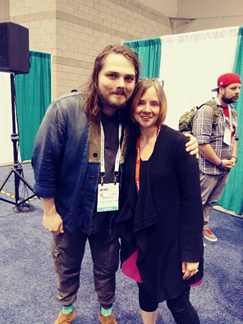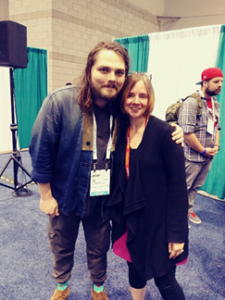This is part of a series of Session Notes from grantees who have received Professional Development grants from the Office of Commonwealth Libraries. Each grantee will share their professional development experience and include tips and other resources from the workshop or class. Grantees had their choice of an article for the Compendium, a webinar or a podcast. This project was made possible by the Institute of Museum and Library Services.
by Mary Glendening
Middletown Free Library
Thanks to a Professional Development Grant from the State Library, I had the opportunity to attend this year’s American Library Association’s Annual Conference in Chicago, IL. I attended a variety of pre-conferences and sessions on everything from games and gaming in the library to creating movie making programs at the library.
The Middletown Free Library runs a lot of programs throughout the year and we are always looking at new ideas to incorporate into our programming so I attended the Escape the Library Preconference on Friday morning. This was a fun and informative session on planning escape experiences in the library. We had the opportunity to participate in several escape experiences that have been successfully run in school, public and academic library settings. Escape experiences can be a great way to promote library services and partner with other organizations in the community and they can be adapted to run with different ages, employ different skills and adapt to the size of the group you are working with. You can even create an “Escape Room in a Box” kit to circulate in your community.
 Elements of a good escape experience include puzzles that players have to solve to unlock the box or get the next clue. Time management comes into play as most escape experiences have a time limit to complete. Players will need to work together to solve the puzzles and move along in the story. Lastly, story is very important. The escape experience is part of a story that the action and puzzles take place around. You can use escape experiences that have been designed by others to get experience with how a good escape experience works and then use this experience to start designing your own escape experiences. Escape experiences are a great way to collaborate with other organizations in your community. You can design an experience to promote a service, explore the history of your community and more.
Elements of a good escape experience include puzzles that players have to solve to unlock the box or get the next clue. Time management comes into play as most escape experiences have a time limit to complete. Players will need to work together to solve the puzzles and move along in the story. Lastly, story is very important. The escape experience is part of a story that the action and puzzles take place around. You can use escape experiences that have been designed by others to get experience with how a good escape experience works and then use this experience to start designing your own escape experiences. Escape experiences are a great way to collaborate with other organizations in your community. You can design an experience to promote a service, explore the history of your community and more.
So what’s so great about escape experiences and how do they fit into the library? Escape experiences can engage the five senses allowing you to make it an immersive experience. While you don’t have to create experiences using all 5 senses, the more senses you engage, the more immersive the experience. Besides providing a new or different type of programming, escape experiences help develop new skills and literacies such as information seeking, puzzle design, critical thinking, working in a team, communication, etc. You can even combine the digital and physical by incorporating a game such as Minecraft or a search in a digital resource to unlock clues as part of your game experience.
Program Ideas involving escape experiences:
- Intergenerational program opportunity
- Escape Camp and Escape Room Design programs
- Incorporate into Gaming programs you already have in your library or use it to build a gaming program
Escape Experience Resources:
http://shushcon.com
https://games.breakoutedu.com/
On Friday I also had the opportunity to participate in a special pre-conference session “Beyond the Racial Stalemate” led by Monica Haslip of Little Black Pearl and Michael Wenger from George Washington University. This session focused on using a method known as “racial healing” which uses story-telling, deep listening and vulnerability to start the necessary conversations that will move us forward and start to breakdown racial hierarchies. This was a very powerful and personal session that I won’t soon forget. Everything that happens in the circle during this session is kept private so that participants have a safe space to express very personal experiences. This session was facilitated by the W. K. Kellogg Foundation. You can find more information at http://www.racialequityresourceguide.org/ and http://www.wkkf.org/.
Friday was a really full day of conference events. The conference kicked off with Reshma Saujani founder of Girls Who Code as the keynote speaker. The exhibits also opened on Friday evening with some great panels at the Gaming & Graphic Novels stage. The highlight was hearing from the creators and artists of DC’s Young Animal imprints with curator Gerard Way and creators Cecil Castellucci, Jody Houser, Jon Rivera and Nick Derington joining Way on stage. This stage would have a lot of great panels throughout the conference. Friday night ended with a great event hosted by the Games and Gaming Roundtable at the Chicago Hilton. ALA Play featured a variety of opportunities to play games and explore makerspace activities in a relaxed and fun atmosphere with activities being run by librarians, creators and game publishers.
Saturday was another busy day with tons of sessions to choose from as well as a full slate of activities, panels and author appearances on the exhibit floor. Session highlights from Saturday included “Filming Our Future: Growing a Video Production Niche in the Ak-Chin Indian Community”. This session was led by Jeffrey Stoffer, Librarian and Cecily Peters, Video Production Assistant at the Ak-Chin Indian Community Library in Arizona. Jeffrey and Cecily talked about growing their Video Production program from a small movie making club in the library into a full production programming which included them making a documentary for the community. They still run the movie club which continues to be popular with youth in the community but they also create library commercials and instructional pieces as well. They were able to grow their program through LSTA grants and video production has become and integral part of their programming. Tips for starting a movie making club at the library include starting small and use what you have. You don’t have to have a bunch of fancy equipment or even know much about editing to get started. Short videos are always great and an iPad or even your phone are all you need to get started recording and making videos. Jeffrey and Cecily recommend the following apps to get started:
- StopAnimator
- Animator (flip-book or post-it note animations)
- iMoive
- Puppet Pals HD
Be sure to Subscribe to the Ak-Chin Library’s YouTube page to see what they are creating at https://www.youtube.com/user/AkChinLibrary.
I also attended a second workshop on using video to promote the library as my Board would like me to start using video to promote the library. This session focused more on using video via social media and solely as a tool for promotion rather than the programming angle of the other presentation. The tips I picked up at this session are of particular interest in how to reach viewers. For example, square and vertical videos get watched more than HD videos on Facebook. Video is very popular on Facebook right now so it’s a good place to upload your videos but be sure to also upload videos to YouTube. It was also emphasized at this session that you don’t need a lot of fancy equipment to make videos, use what you have including your smart phone. If you want to invest some money, purchase a phone friendly microphone for better audio.
 Saturday was rounded out by the launch of Book Club Central with special guest Sarah Jessica Parker. Ms. Parker was announced as the inaugural chair of Book Club Central and was given Lifetime Board Membership in United for Libraries. At the event, the first selection of Book Club Central was announced-No One is Coming to Save Us by Stephanie Powell.
Saturday was rounded out by the launch of Book Club Central with special guest Sarah Jessica Parker. Ms. Parker was announced as the inaugural chair of Book Club Central and was given Lifetime Board Membership in United for Libraries. At the event, the first selection of Book Club Central was announced-No One is Coming to Save Us by Stephanie Powell.
I kicked off Sunday at the YA Author Coffee Klatch which is a sort of speed dating session with Young Adult authors. Over 30 authors participated in this event and each table was visited by about 9 or 10 authors over the course of the morning. Authors with upcoming books or recently published booths I got to meet were:
- Marie Lu—War Cross
- Peter Bognanni—Things I’m Seeing Without You
- Deborah Heiligman—Vincent & Theo
- Daniel Jose’ Older—Bone Street Rhumba sequel to Shadowshaper
- Julie Halpern—Meant to Be
- Anna Marie McLemore—Wild Beauty
- Rob Rufus—Die Young With Me
- Russo—If I Was Your Girl (She will do Skype Chats with libraries, @Mer_Squared)
Later on Sunday I attended a session called “How to Run a Techspace” presented by Rebecca Stavick, Executive Director of Do Space in Ohmaha, Nebraska. Do Space is a “technology library” but it’s not part of a library system. The mission of Do Space is to empower the community through access to technology and innovative learning experiences. It is an interesting space which collaborates with the local community college and it has a Dunkin Donuts inside. They offer free memberships and serve people of all ages. Anyone can join. Rebecca offered some great insights into their space and of particular interest was hearing about staffing Do Space. The things they look for when they hire staff for the space are that soft skills are more important than tech skills, you should hire people who like people, are mission driven and don’t worry about educational background. A college degree is not needed to work in a tech space. If you hire curious people they will keep up with changing trends, learn through doing and be willing to jump in where needed. If you are thinking about starting a tech space, you should think about how it fits into the mission of your library and remember your audience when you speak about your space and your ideas for your space. Don’t get bogged down with creating a lot of rules as too many rules and restrictions get in the way of innovation and the creative process. One cool program they are running at Do Space is called Cyber Seniors. In this program, seniors teach other seniors technology. You can find out more about Do Space at http://www.dospace.org/.
Monday was my last day at the conference and as I only had the morning I had to pack a lot into a small amount of time. One of the best sessions I attended at ALA was presented by Nancy Evans of the Levittown Public Library in NY. Her presentation, “Strong Girls School: Create a Program Addressing Gender, Bias, Inequality and Self-Esteem Building for Girls” offered a lot of great tips on how to start a similar program at any library. Nancy runs this program as a club but it originally started out as a series of programs for girls in grades 6-12. The club tackles tough topics such as gender, stereotypes and bias, beauty, body image & media, healthy relationships & friendships, rape culture, staying safe and self-esteem/self-image. This type of program works best as a small group of no more than 6-8 girls but it can be hard to turn people away as the topics being discussed are important. Each week they look at a new topic through worksheets, discussion, video, etc. While the age range may seem wide considering the topics being discussed there have been no complaints from parents of the girls who attend. The older girls will end up mentoring the younger girls sharing their experiences and tips for getting through middle school. The question came up about whether or not a librarian is qualified to offer such a program and shouldn’t an expert be brought in to run the program.
Nancy reminded the audience that libraries run all kinds of programs that we are not expert in such as STEM programming and no, you don’t need to be a therapist to run a Strong Girls School. The program is about connecting people with information which is what librarians do every day. While the club is not aimed at Gender Fluid or Trans Youth, there should be no issue in someone who identifies as gender fluid or Trans in participating. They currently are not running any kind of similar program for LGTBQ+ youth but are exploring the idea. She said her community is very conservative so programs aimed at LGTBQ+ youth are harder for them to implement.
I am so grateful that I had the opportunity to attend ALA this year. This is the first opportunity I have had to attend and it was a fantastic experience.


